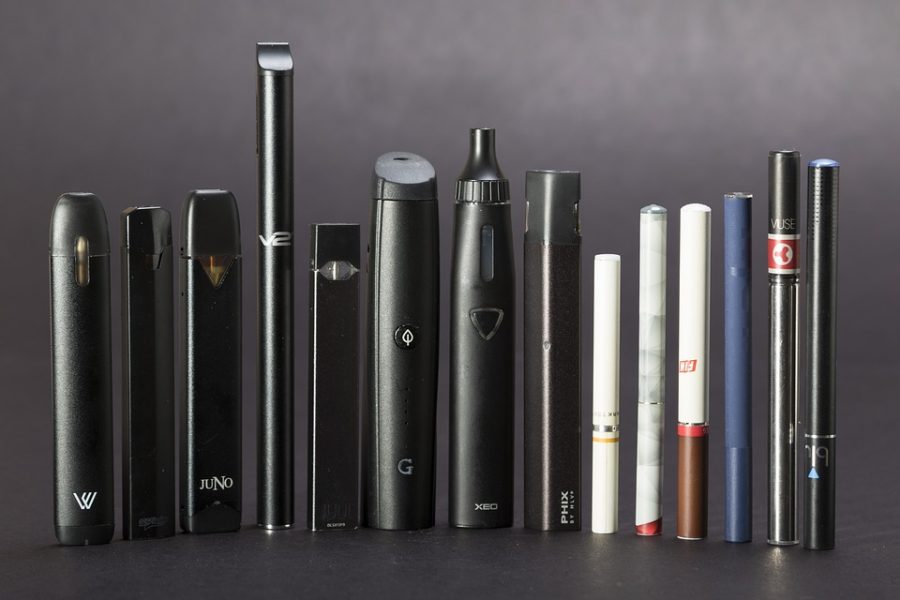Jesuit’s lack of treatment-based education perpetuates addiction stigma
Addiction: Education and Treatment for High Schools that Face a Potential Crisis
OPINION

SHAWNA MUCKLE
Chief Editor
JUUL usage among high school students has inspired concern about the reemergence of nicotine addiction. With this increased concern comes a need to examine the defects of current addiction education and stigma—defects that Jesuit is by no means immune to.
Many high schools, including Jesuit, offer widespread preventative education for addiction. Preventative education teaches students about the addictive properties and harmful physical, mental and emotional effects of various substances. In health classes, teachers have begun placing an emphasis on e-cigarettes in particular, encouraging students to initiate their own questions. “I think it’s important to have vaping education, but I also think it’s important for kids to ask the questions they want to know,” Health teacher Ms. Kaempf said. “I want my students to have ownership over their own learning.” While understanding the science behind addiction remains a crucial deterrent for teenagers considering experimentation with substances, it does little to help kids already struggling with addiction, where symptoms are beyond their control.
The other side of addiction education is treatment education: education that focuses on assessing treatment and rehabilitation options for existing addictions.Education on addiction resources, including school resources, may seem geared only towards addicted students, but treatment education provides important information to the entire school community. It confronts stigma and misinformation surrounding people suffering from addiction, and it helps students feel safe coming forward about potentially addictive behaviors in themselves or their peers, rather than leaving addiction assessments to adults on campus.
For faculty, detecting seriously-addicted students is often difficult. Given that most adults on campus are only able to observe and look out for students during the school week, faculty have limited insight into students’ substance usage and level of drug dependence, including nicotine. On-campus drug usage, although a serious breach of school rules, is one of the few methods the administration has to identify struggling students.
“If a student is doing these things frequently on campus, it leads me to believe they have a problem,” said Mr. Maxie, Vice Principal of Academics and Student Life. “I am first and foremost concerned about their health and well-being. I want you to get the help that you need, which means I’m going to connect you with your counselor and hopefully together we’ll be able to find out if there’s a true issue there.”
On-campus drug usage typically involves suspension, and in most circumstances students are still allowed to be part of the community. However, the administration addresses drug use on a case-by-case basis, depending on a student’s prior discipline record.
While Jesuit has not standardized treatment-focused education in any particular class, Mr. Maxie stresses that the administration prioritizes directing students it knows are struggling with substance abuse towards their counselors to develop a treatment plan that is effective for them, whether that’s rehabilitation, counseling, or other methods to treat addiction.
School counselors are not considered mandatory reporters regarding illegal substance abuse, and students can come forward about problems about substance addiction without necessarily having those issues referred back to the administration or to law enforcement. Counselors also serve as the primary contact between outside psychiatrists and rehabilitation centers for a variety of mental illnesses, including addiction.
Among the student body, however, rumors and a lack of clarification by the administration have led students to believe the protocol for substance abuse is entirely centered around consequences. No class emphasizes giving students information on any of the internal and external resources Jesuit has to help students caught using substances—leaving many with the assumption that those resources don’t exist at all.
“I do think when there’s actual instances of drug addiction or nicotine usage in the Jesuit community that we fail to address the issue, which is the addiction itself and not the fact that rules were broken,” junior Lucy Keane said. “I think it’s centered around consequences like suspension. I think it would be more beneficial if rehabilitation resources and resources that would support the student in overcoming this challenge they are facing were more available.”
“No class emphasizes giving students information on any internal and external resources Jesuit has to help students caught using substances—leaving many with the assumption that those resources don’t exist at all.”
The misinformation that surrounds Jesuit’s role in treatment assistance also helps explain the minimal amount of students who reach out about addiction-related problems.
“We have not had many students or families contact us looking for resources to help deal with addiction of any kind, partly because of the stigma [around addiction] and they don’t want the school to know, but hopefully because they are actively seeking their own programs,” Principal Mr. Hogan said.
The stigma that prevents students from coming forward links back to the flawed standards for addiction education. In light of climbing addiction rates, Oregon implemented more standards in 2018 for presenting information on the risks and problems associated with addiction to students (The Lund Report). However, no expectations—either at the state level or in Jesuit’s current preventative curriculum—clearly address possible treatments or the specific consequences school has in place for substance abuse.
Without education on Jesuit’s efforts to treat addiction, students are unlikely to assume they will be cared for by their counselors or the administration if they are caught with substances or come forward on their own.
When objective information on how to curb addiction, not just how to avoid it, is neglected in health classes, students experiencing addiction have trouble evaluating different treatment options. For nicotine addiction from e-cigarettes in particular, medical treatment options commonly prescribed to students may have no evidence to confirm their efficacy.
Nicotine-replacement mechanisms meant to minimize the symptoms of withdrawal, such as gum and patches, have little evidence for lessening nicotine dependence in young adults addicted to vaping (Time).
Without a comprehensive education on addiction treatment, or substantial counselor aid in assessing their options, addicted teenagers often feel too stigmatized to seek additional help in assessing treatment options. They often end up choosing the first treatment method their doctor suggests, which may be non-evidence based (Vox). Even more likely, students may feel too ashamed or in denial to seek treatment at all, especially if their parents haven’t recognized any addiction symptoms.
While Jesuit may only rarely have incidents with students experiencing addiction, of the 20% of high school students who vape on a regular basis (Washington Post), many may be developing a dangerous dependence. Jesuit students have received enough education to recognize that dependence, but few have learned how to combat it. Some likely have yet to come forward or seek help.
Treatment education, alongside education on the science and risks behind addiction, should become an emphasized aspect of the health curriculum and a central component of schoolwide efforts to improve addiction education. Students should know much more about the resources available to them in the counseling department for dealing with addiction and other mental illnesses. The consequences of substance use should be honestly portrayed to students and shouldn’t remain subject to rumor and conjecture.
A straightforward explanation about how addiction can be treated, and in cases of on-campus drug usage, what both the punishments and treatments offered to students are, by no means encourages more students to abuse substances.
Having a clear picture of the realities of having an addiction, namely treatment, will enable students to rationally self-assess their behaviors and choose appropriate, evidence-based treatment. Being informed on their available resources within Jesuit will empower students whose symptoms and usage are “undetectable“, particularly common among e-cigarette users, to come forward with less shame or uncertainty.
As for the students who aren’t currently struggling with substances, understanding that addiction treatments exist even within our school, even for high schoolers, will help eliminate addiction’s reputation as an ugly, incurable disease.
Seeing addiction from a solution-based standpoint, alongside the cautionary information that preventative education offers, is integral for eliminating the stigma around addiction that prevents others from seeking treatment. Addiction is so widespread, and nicotine addiction is increasing so rapidly among high schoolers, that no student should remain ignorant about various treatment resources.

Shawna Muckle, 17, is a senior at Jesuit High School. She has been a member of the Chronicle staff for three years in various capacities, and she is currently one of its chief editors. Shawna is fascinated by politics and government, and she enjoys writing articles for the Chronicle pertaining to local and national political developments, alongside issues tied to social justice and personal identity. Some of her favorite pieces she’s written include a feature on Jesuit students’ experience with microaggressions, a recap of the 2018 midterm elections, and an article discussing last year’s clerical abuse scandal within the Catholic Church. Outside of journalism, Shawna is the leader of Jesuit’s Model United Nations club and a member of her school’s Ethics Bowl team, which was a 2019 national champion. Shawna is also a Precinct Committee Person for the Washington County Democrats. In her free time, Shawna can be found aggressively running up hills, drinking boba, and yeeting off on road trips to Seattle (for unspecified reasons). Ask her about her opinions on Congress, specifically a) Republicans and b) the crisis with the federal deficit. In the future, Shawna hopes to pursue journalism in college and, later on, as a congressional reporter in DC.













